The dangers of swimming in France's seas, lakes, rivers and pools you need to know about
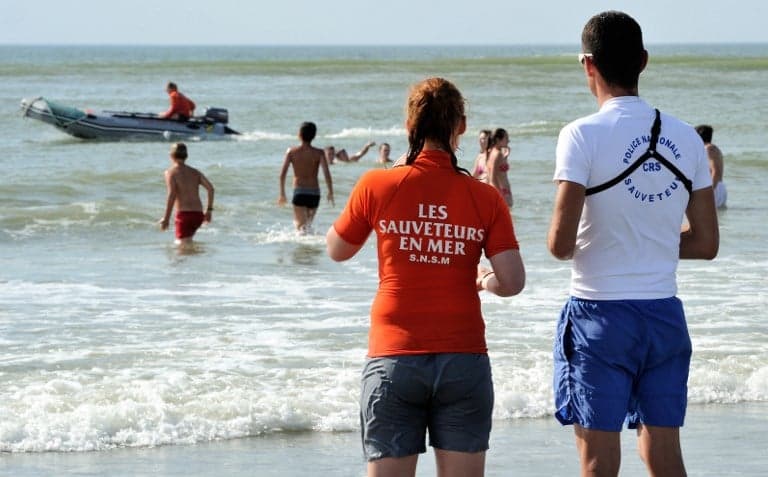
With roughly 500 fatal drownings in France each summer - many of the victims being young children, it's vital that the public and especially tourists know the different dangers of taking a dip on the Normandy, Atlantic or Mediterranean coasts as well as in the many rivers, lakes and private swimming pools.
On July 12, French health authorities released shocking figures aimed at grabbing the attention of holidaymakers, in particular parents and people who are not strong swimmers.
From June 1st to July 5th 2018, there were 121 fatal drownings around France, as well as 552 accidents linked to swimming. On average every summer there are around 500 fatal drownings.
Most of these accidents involved children, such as the tragic case of three young siblings who wanted to cool their legs in a man-made lake in central France, but slipped in and drowned.
But the risk of drowning exists even for the strongest of swimmers; it all depends on their ability to foresee potential dangers in different types of swimming locations.
For instance, the Mediterranean sea takes the lives of more French swimmers than the Atlantic Ocean, and yet the latter’s tides are stronger and generally considered more treacherous.
Here we take a look at the different types of precautions to keep in mind while holidaying anywhere near water in France.
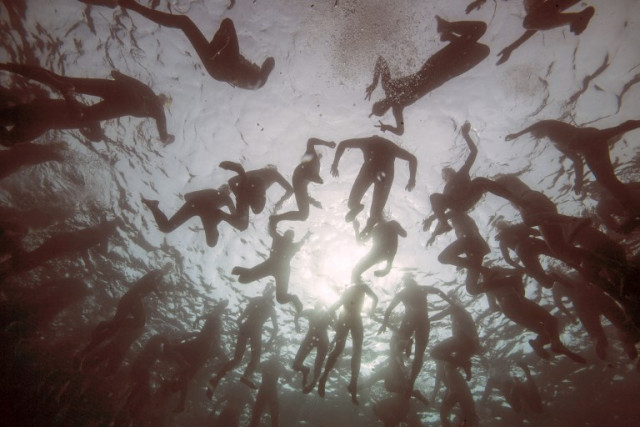
At sea
France’s coastline has been witness to roughly half of all fatal drownings in the country over the past few years.
Some regions in north-west France such as the southern beeches of Brittany are renowned for their strong waves whereas in Normandy the danger is more linked to the tides which surprise people who have gone for a stroll on the beach and suddenly find themselves trapped by quickly rising waters.
The Atlantic
But all along the Atlantic coast there exists a phenomenon that is unique to the Nouvelle- Aquitaine region, one that has its own set of particular risks.
Baïnes are small pools of water that run parallel to the beach and are directly connected to the sea’s waves, tides and currents. When the tide goes out, it causes a very strong current heading out to sea.
The word "baine" comes from Occitanie word for small basin or pool. They give the impression that they are pools of calm water but under the surface there are strong currents that can quickly take people out to trouble. The image below is of a young person being rescued after getting swept out to sea by the current in a baine.
Every year some 4,300 bathers get into trouble after being caught in the current in a baine.
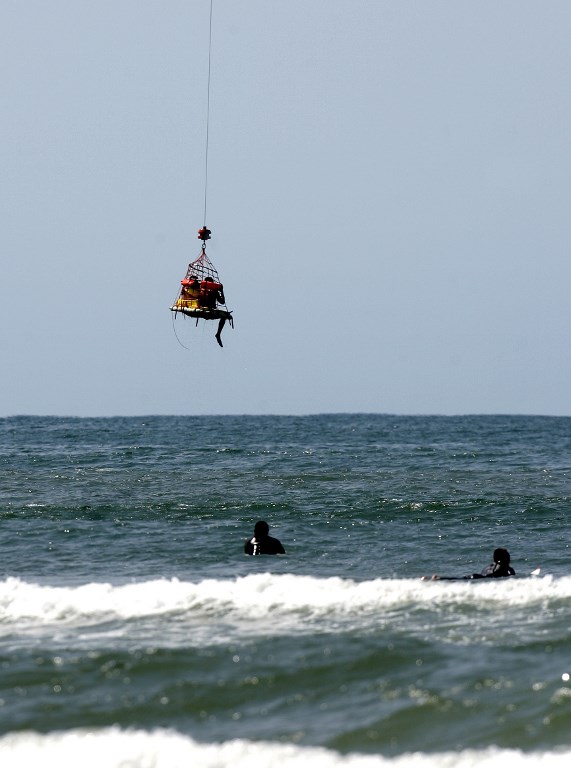
The current will vary depending on the height of the waves and the height of the tide.
They’re strongest and most dangerous during the final hours of low tide and the first hours of high tide.
Each baïne has its own morphology and behaviour, which results in many swimmers and surfers inadvertently being pulled further out to sea, in many cases leading to fatal drownings.
This image from the Lacarno Surf Info website highlights the phenomenon of baines and their currents.
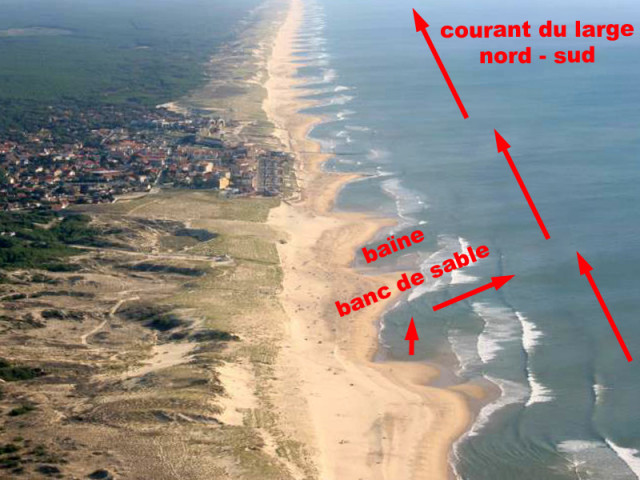
Police lifeguard Jean-Baptiste Rivet told La Depeche newspaper that if you do end up caught in a current from a baine and are swept out to sea then the most important thing is not to fight it because that will increase fatigue and your chances of drowning.
"The current from the baine can pull you 200 metres out to sea but you will systematically be brought back to the shore a few hundred metres to the south," he said.
"Drowning is always due to the fact that people are exhausted trying in vain to swim against the current, while on the contrary we must go with it."
Pay special attention if you’re holidaying along the Atlantic in Gironde, Charente-Maritime or Landes but also in Brittany. And always swim in areas under observation by lifeguards. If you have any doubts about swimming then go and ask a lifeguard.
In the Landes department alone some 58 out of 77 drownings between 1995 and 2015 occurred in baines, that were not under the close watch of lifeguards.
Shorebreaks
Bathers in the Atlantic also need to be aware of the dangers of huge waves known as "shorebreaks" that break on the sand or in very shallow water. They can cause broken bones and in the summer of 2015 one wave broke the back of a British tourist and led to his drowning.
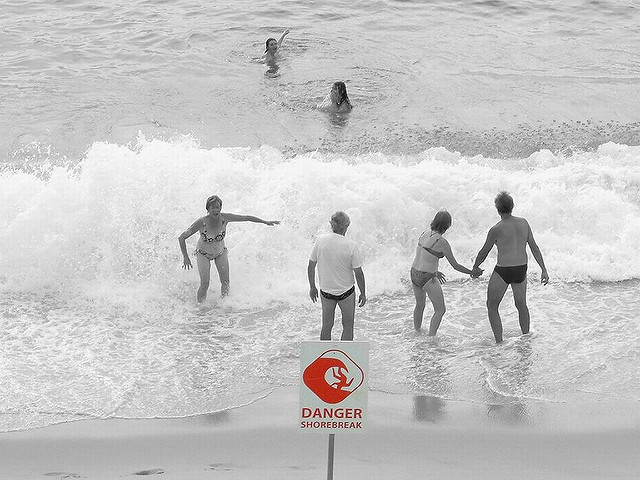
The Med
Despite this unique set of risks along France’s often-perilous Atlantic coastline, the Mediterranean Sea, especially in the country’s PACA region, is frequently responsible for more deaths by drowning.
“In 2012, 59 drownings took place in Alpes-Maritimes and 50 in Herault, compared to 59 in Charente-Maritime, 43 in Gironde, or 36 in the Landes ," the head of France’s Ocean Surf Report was quoted as saying by Marie Claire.
These stats highlight the fact that holidaymakers are prone to letting down their guard while swimming in the Mediterranean, especially during the busy summer months.
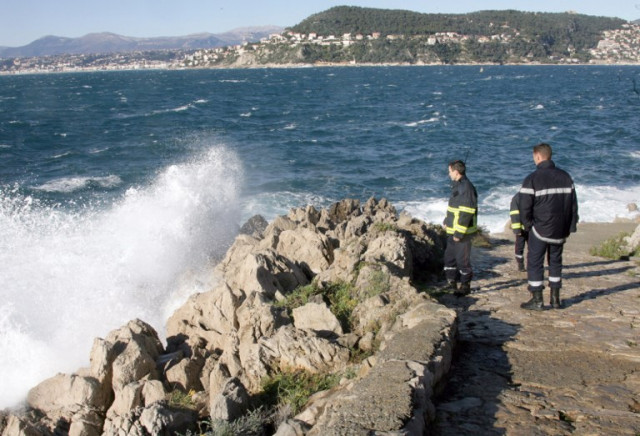
“It's a disaster because holidaymakers don’t believe that the Mediterranean is a danger," Karine, lifeguard at Palavas-les-Flots beach in Hérault, told RTL.
"They’re convinced that the Atlantic is dangerous but the Mediterranean is more dangerous in terms of big swells and countercurrents.
“They simply don’t listen to us.”
On the subject, Lieutenant Pasqualini, a French firefighter, told Europe 1 radio: “The Mediterranean has its dangers, its peculiarities, due to the fact the wind can change quickly and without warning, but also because of certain currents, notably near the dykes”.
Swimmers are also advised to learn of the possible dangerous currents at each beach, which should be displayed at each aid station.
One problem the Mediterranean has over the Atlantic is that many young people especially drink alcohol in the beach resorts and then head into the water.
"Before they know it they are drifting out to sea,” firefighter Pasqualini said.
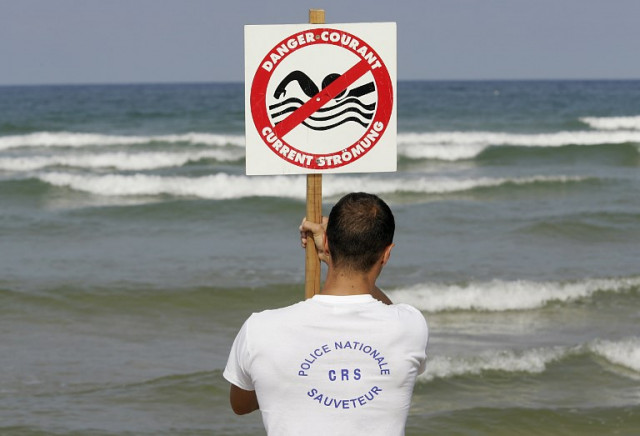
So remember that swimming is only safe if the green flag is hoisted. If the red flag is up or a sign like the one above, stay out of the water.
As we have already said if you do run into trouble "don’t fight against the current and the waves or you’ll become exhausted," France National Institute for Prevention and Health Education (INVS) advises.
If you do get tired the best advice is to "lie on your back to rest”, as your airways will be clear and you’ll have better chances of recovering a normal breathing pattern.
Rather than fighting the current, your best options are letting yourself be carried along, try to get the attention of bystanders or swim 90 degrees in the direction of the current to try to escape.
Men over the age of 45 made up more than half of all accident victims at sea in France in 2012.
Incidents that resulted in fatal drownings affected men over the age of 65 in particular, as their loss of physical capabilities are made worse by cardiac arrest and other health problems.
And always stay close to young children and do not let them go into the water alone.
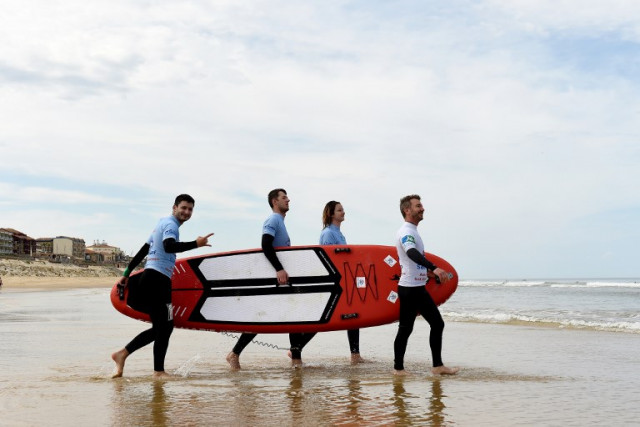
Practicing water sports in the wrong conditions also entails risks, as activities such as sailing or surfing account for 20 percent of deaths by drowning at sea.
If you’ve gone out to sea on a boat, make sure you always take a lifejacket with you. When people fall without a vest from their boat, they will immediately enter a state of panic and are much more likely to drown.
As for paddle-boarding - an increasingly popular sport where you stand up on a surfboard while paddling your way through the sea – the dangers are much the same.
In fact, the chances of falling ‘overboard’ are much greater, making the need for a lifejacket even more essential. Novice paddlers have less control over their movements and their reactions to currents, so they’re more likely to be quickly and unwillingly pulled out offshore.
Keep in mind also that sea temperatures can vary greatly, so if you don’t know the area well and have access to a wetsuit, wear one to avoid a shock to the system if the water becomes very cold.
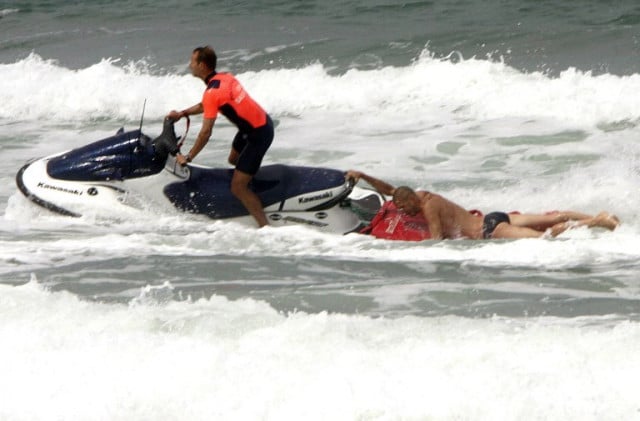
According to a 2012 study into drowning risks by France’s public health surveillance body, 51 percent of people who drown in l’Héxagone do so in areas they are not from.
It’s therefore advisable to consult locals beforehand about any risks you might face at the particular beach you’re going to.
The same goes for checking the weather forecast on the day, as you could find yourself caught out at sea when a storm comes.
Normandy and the north coast
In Normandy in 2016 some 154 rescue operations had to be launched after walkers and swimmers were caught out by rising rides. Many of those rescued were from abroad or from other parts of France and so likely had no idea of the dangers the tides on the north coast of France can cause.
At low tide the sea along the beaches of northern France can retreat several hundred metres or even several kilometres offshore, which encourages people taking a stroll as well as families with young kids to head well away from the shore to reach the water.
When the tide begins to come in again it can only take a few minutes before people are taken by surprise and left stranded on a sand bank by the rising waters.
.jpg) (Dennis Jarvis/Flickr)
(Dennis Jarvis/Flickr)
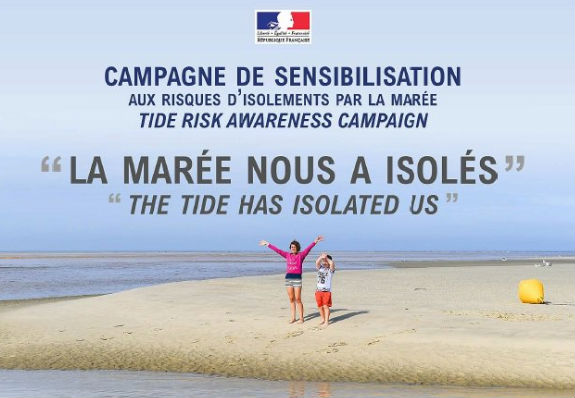
Visitors are urged to consult the times of the tides before heading on to the beach so they know exactly when the sea will begin to head back to the shore. In emergencies anyone caught out can call the special number 196.
People also just need to be aware of their position and how they can get back to the shore via sand banks.
Rivers and lakes
Swimming in lakes is like swimming in the sea and should only be done in supervised areas, if it is allowed that is. In some lakes swimming will be banned altogether.
The first thing to keep in mind when swimming in France’s lakes and river is the temperature shock.
Lake water cools 20 times faster than air so you may be in for a somewhat nasty surprise if you take a sudden jump into a near-freezing lake.
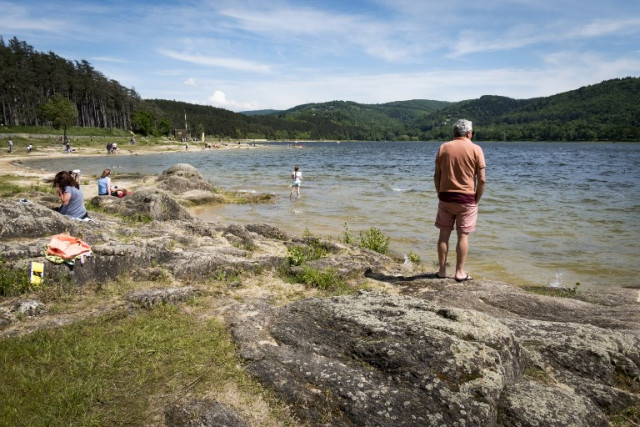
If you do fall into or swim in waters at 10 degrees Celsius, you are likely to suffer body paralysis after ten minutes, which can result in loss of body coordination.
Very cold temperatures lead the body’s blood to be squeezed towards the heart, which struggles to absorb this influx and can result in a person losing consciousness and drowning.
Lake and river swimmers should enter the water slowly to allow their systems to acclimatise. This will prevent your body from entering a state of thermal shock with can lead to hydrocution, or cold-water drowning.
Then there’s the issue of depth. Unlike on a beach where you can generally move gently downwards into the water, the banks of lakes, streams and rivers can have a sudden vertical drop that’s often unexpected by swimmers.
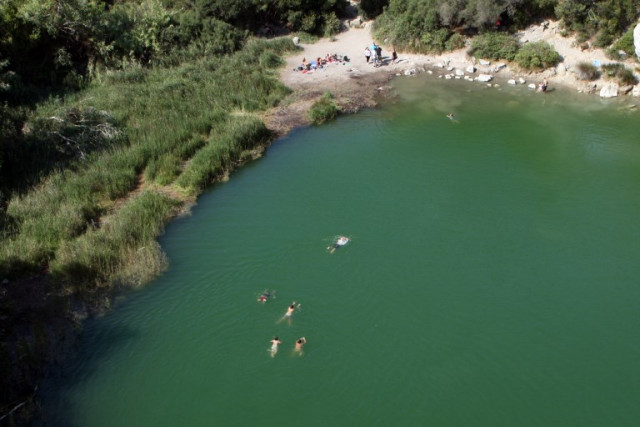
Watch your footing as you enter and expect potential slumps in the waterbed as you move further in. If you’re not a strong swimmer, take extra precautions.
Rivers and streams are of course also prone to having strong currents and similar swirling to that caused by baïnes in the Atlantic.
This is also a risk when water skiing, kayaking in fresh water, so make sure you have adequate protection equipment to improve your chances of getting out of a difficult situation.
Swimming pools
In the summer of 2015 there were 59 fatal drownings in private family swimming pools in France and another 121 non-fatal incidents.
Tragically, most of these victims are children under the age of six. Many of the deaths occur in rented villas or summer houses where the parents and children might not be used to having a pool and are not aware of all the dangers and safety precautions needed.
Private pools in France must have some kind of security measure whether it's a fence around he water or a cover. Parents are advised to use these whenever the pool is not is use.
It’s important for parents to remember it only takes 20 centimetres of water for a small child to drown in three minutes, often without making any noise or splashing.
Even though swimming pools hold the majority of risks, any container with water, be it a bathtub, a basin, a bucket or a small inflatable pool can put a young child or baby at risk if unmonitored.
Drowning is the leading cause of accidental death in young children in France, followed by suffocation, fire accidents and falls.
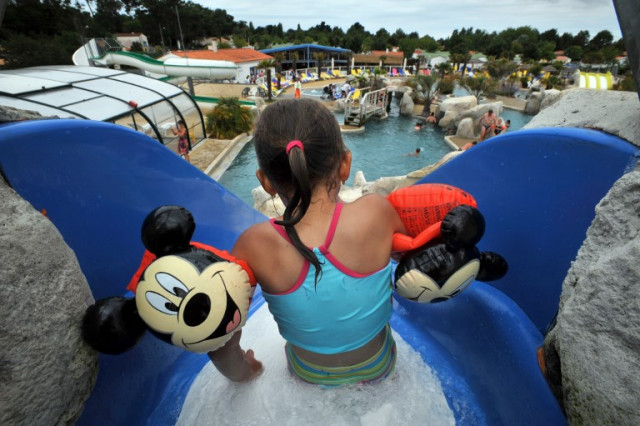
Even for children under 15, drowning is the second leading cause of accidental death after traffic accidents, France’s Health Monitoring Institute (INVS) reports.
Authorities are urging parents to keep a close watch on their children at all times this summer, and that includes water parks, hotels and gîte holiday homes with swimming pools, which are the scene of many tragic drownings each summer.
Even if there is a lifeguard or supervisor present at a public pool, they are likely to be monitoring many children and adults at the same time, so it’s important to never lose sight of your young children while they swim.
With older kids, games involving holding their breath underwater can also be risky if unmonitored and are overall best avoided. The same goes for any kind of dangerous showboating such as somersaulting off the pool edge.
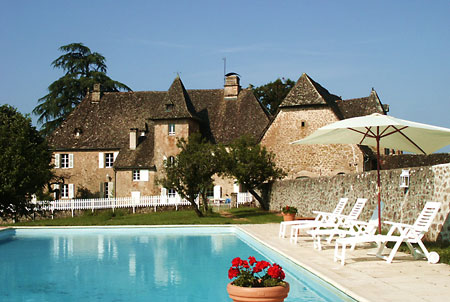
If you’re a parent or guardian who is staying at a home with a pool, explain the dangers of the pool to children and ban them from swimming without an adult being present.
Pay attention to the pool edge and warn children if it’s slippery. If you have young children, remove toys and inflatables from the pool when you’re not using the pool to stop them from trying to reach out to grab them when you’re not present.
There are also floating swimsuits that you can buy for kids as well as the regular armbands to keep them afloat.
As an extra precaution, lock the house doors when you’re indoors with your kids to stop them from potentially wandering off out into the swimming pool area. You can also be extra prepared for any eventuality by knowing the basics of first aid and having a first aid kit handy.
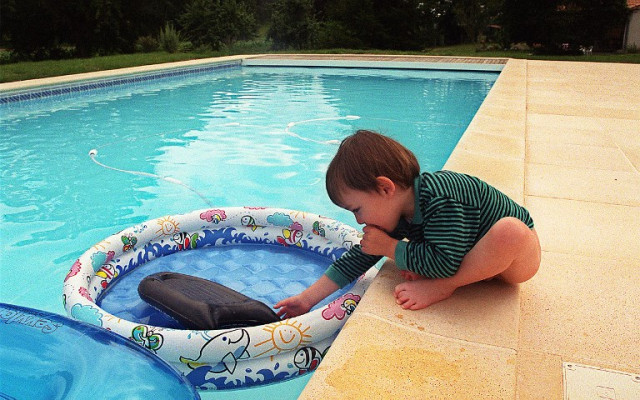
Comments
See Also
On July 12, French health authorities released shocking figures aimed at grabbing the attention of holidaymakers, in particular parents and people who are not strong swimmers.
From June 1st to July 5th 2018, there were 121 fatal drownings around France, as well as 552 accidents linked to swimming. On average every summer there are around 500 fatal drownings.
Most of these accidents involved children, such as the tragic case of three young siblings who wanted to cool their legs in a man-made lake in central France, but slipped in and drowned.
But the risk of drowning exists even for the strongest of swimmers; it all depends on their ability to foresee potential dangers in different types of swimming locations.
For instance, the Mediterranean sea takes the lives of more French swimmers than the Atlantic Ocean, and yet the latter’s tides are stronger and generally considered more treacherous.
Here we take a look at the different types of precautions to keep in mind while holidaying anywhere near water in France.

At sea
France’s coastline has been witness to roughly half of all fatal drownings in the country over the past few years.
Some regions in north-west France such as the southern beeches of Brittany are renowned for their strong waves whereas in Normandy the danger is more linked to the tides which surprise people who have gone for a stroll on the beach and suddenly find themselves trapped by quickly rising waters.
The Atlantic
But all along the Atlantic coast there exists a phenomenon that is unique to the Nouvelle- Aquitaine region, one that has its own set of particular risks.
Baïnes are small pools of water that run parallel to the beach and are directly connected to the sea’s waves, tides and currents. When the tide goes out, it causes a very strong current heading out to sea.
The word "baine" comes from Occitanie word for small basin or pool. They give the impression that they are pools of calm water but under the surface there are strong currents that can quickly take people out to trouble. The image below is of a young person being rescued after getting swept out to sea by the current in a baine.
Every year some 4,300 bathers get into trouble after being caught in the current in a baine.

The current will vary depending on the height of the waves and the height of the tide.
They’re strongest and most dangerous during the final hours of low tide and the first hours of high tide.
Each baïne has its own morphology and behaviour, which results in many swimmers and surfers inadvertently being pulled further out to sea, in many cases leading to fatal drownings.
This image from the Lacarno Surf Info website highlights the phenomenon of baines and their currents.

Police lifeguard Jean-Baptiste Rivet told La Depeche newspaper that if you do end up caught in a current from a baine and are swept out to sea then the most important thing is not to fight it because that will increase fatigue and your chances of drowning.
"The current from the baine can pull you 200 metres out to sea but you will systematically be brought back to the shore a few hundred metres to the south," he said.
"Drowning is always due to the fact that people are exhausted trying in vain to swim against the current, while on the contrary we must go with it."
Pay special attention if you’re holidaying along the Atlantic in Gironde, Charente-Maritime or Landes but also in Brittany. And always swim in areas under observation by lifeguards. If you have any doubts about swimming then go and ask a lifeguard.
In the Landes department alone some 58 out of 77 drownings between 1995 and 2015 occurred in baines, that were not under the close watch of lifeguards.
Shorebreaks
Bathers in the Atlantic also need to be aware of the dangers of huge waves known as "shorebreaks" that break on the sand or in very shallow water. They can cause broken bones and in the summer of 2015 one wave broke the back of a British tourist and led to his drowning.

The Med
Despite this unique set of risks along France’s often-perilous Atlantic coastline, the Mediterranean Sea, especially in the country’s PACA region, is frequently responsible for more deaths by drowning.
“In 2012, 59 drownings took place in Alpes-Maritimes and 50 in Herault, compared to 59 in Charente-Maritime, 43 in Gironde, or 36 in the Landes ," the head of France’s Ocean Surf Report was quoted as saying by Marie Claire.
These stats highlight the fact that holidaymakers are prone to letting down their guard while swimming in the Mediterranean, especially during the busy summer months.

“It's a disaster because holidaymakers don’t believe that the Mediterranean is a danger," Karine, lifeguard at Palavas-les-Flots beach in Hérault, told RTL.
"They’re convinced that the Atlantic is dangerous but the Mediterranean is more dangerous in terms of big swells and countercurrents.
“They simply don’t listen to us.”
On the subject, Lieutenant Pasqualini, a French firefighter, told Europe 1 radio: “The Mediterranean has its dangers, its peculiarities, due to the fact the wind can change quickly and without warning, but also because of certain currents, notably near the dykes”.
Swimmers are also advised to learn of the possible dangerous currents at each beach, which should be displayed at each aid station.
One problem the Mediterranean has over the Atlantic is that many young people especially drink alcohol in the beach resorts and then head into the water.
"Before they know it they are drifting out to sea,” firefighter Pasqualini said.

So remember that swimming is only safe if the green flag is hoisted. If the red flag is up or a sign like the one above, stay out of the water.
As we have already said if you do run into trouble "don’t fight against the current and the waves or you’ll become exhausted," France National Institute for Prevention and Health Education (INVS) advises.
If you do get tired the best advice is to "lie on your back to rest”, as your airways will be clear and you’ll have better chances of recovering a normal breathing pattern.
Rather than fighting the current, your best options are letting yourself be carried along, try to get the attention of bystanders or swim 90 degrees in the direction of the current to try to escape.
Men over the age of 45 made up more than half of all accident victims at sea in France in 2012.
Incidents that resulted in fatal drownings affected men over the age of 65 in particular, as their loss of physical capabilities are made worse by cardiac arrest and other health problems.
And always stay close to young children and do not let them go into the water alone.

Practicing water sports in the wrong conditions also entails risks, as activities such as sailing or surfing account for 20 percent of deaths by drowning at sea.
If you’ve gone out to sea on a boat, make sure you always take a lifejacket with you. When people fall without a vest from their boat, they will immediately enter a state of panic and are much more likely to drown.
As for paddle-boarding - an increasingly popular sport where you stand up on a surfboard while paddling your way through the sea – the dangers are much the same.
In fact, the chances of falling ‘overboard’ are much greater, making the need for a lifejacket even more essential. Novice paddlers have less control over their movements and their reactions to currents, so they’re more likely to be quickly and unwillingly pulled out offshore.
Keep in mind also that sea temperatures can vary greatly, so if you don’t know the area well and have access to a wetsuit, wear one to avoid a shock to the system if the water becomes very cold.

According to a 2012 study into drowning risks by France’s public health surveillance body, 51 percent of people who drown in l’Héxagone do so in areas they are not from.
It’s therefore advisable to consult locals beforehand about any risks you might face at the particular beach you’re going to.
The same goes for checking the weather forecast on the day, as you could find yourself caught out at sea when a storm comes.
Normandy and the north coast
In Normandy in 2016 some 154 rescue operations had to be launched after walkers and swimmers were caught out by rising rides. Many of those rescued were from abroad or from other parts of France and so likely had no idea of the dangers the tides on the north coast of France can cause.
At low tide the sea along the beaches of northern France can retreat several hundred metres or even several kilometres offshore, which encourages people taking a stroll as well as families with young kids to head well away from the shore to reach the water.
When the tide begins to come in again it can only take a few minutes before people are taken by surprise and left stranded on a sand bank by the rising waters.
.jpg) (Dennis Jarvis/Flickr)
(Dennis Jarvis/Flickr)

Visitors are urged to consult the times of the tides before heading on to the beach so they know exactly when the sea will begin to head back to the shore. In emergencies anyone caught out can call the special number 196.
People also just need to be aware of their position and how they can get back to the shore via sand banks.
Rivers and lakes
Swimming in lakes is like swimming in the sea and should only be done in supervised areas, if it is allowed that is. In some lakes swimming will be banned altogether.
The first thing to keep in mind when swimming in France’s lakes and river is the temperature shock.
Lake water cools 20 times faster than air so you may be in for a somewhat nasty surprise if you take a sudden jump into a near-freezing lake.

If you do fall into or swim in waters at 10 degrees Celsius, you are likely to suffer body paralysis after ten minutes, which can result in loss of body coordination.
Very cold temperatures lead the body’s blood to be squeezed towards the heart, which struggles to absorb this influx and can result in a person losing consciousness and drowning.
Lake and river swimmers should enter the water slowly to allow their systems to acclimatise. This will prevent your body from entering a state of thermal shock with can lead to hydrocution, or cold-water drowning.
Then there’s the issue of depth. Unlike on a beach where you can generally move gently downwards into the water, the banks of lakes, streams and rivers can have a sudden vertical drop that’s often unexpected by swimmers.

Watch your footing as you enter and expect potential slumps in the waterbed as you move further in. If you’re not a strong swimmer, take extra precautions.
Rivers and streams are of course also prone to having strong currents and similar swirling to that caused by baïnes in the Atlantic.
This is also a risk when water skiing, kayaking in fresh water, so make sure you have adequate protection equipment to improve your chances of getting out of a difficult situation.
Swimming pools
In the summer of 2015 there were 59 fatal drownings in private family swimming pools in France and another 121 non-fatal incidents.
Tragically, most of these victims are children under the age of six. Many of the deaths occur in rented villas or summer houses where the parents and children might not be used to having a pool and are not aware of all the dangers and safety precautions needed.
Private pools in France must have some kind of security measure whether it's a fence around he water or a cover. Parents are advised to use these whenever the pool is not is use.
It’s important for parents to remember it only takes 20 centimetres of water for a small child to drown in three minutes, often without making any noise or splashing.
Even though swimming pools hold the majority of risks, any container with water, be it a bathtub, a basin, a bucket or a small inflatable pool can put a young child or baby at risk if unmonitored.
Drowning is the leading cause of accidental death in young children in France, followed by suffocation, fire accidents and falls.

Even for children under 15, drowning is the second leading cause of accidental death after traffic accidents, France’s Health Monitoring Institute (INVS) reports.
Authorities are urging parents to keep a close watch on their children at all times this summer, and that includes water parks, hotels and gîte holiday homes with swimming pools, which are the scene of many tragic drownings each summer.
Even if there is a lifeguard or supervisor present at a public pool, they are likely to be monitoring many children and adults at the same time, so it’s important to never lose sight of your young children while they swim.
With older kids, games involving holding their breath underwater can also be risky if unmonitored and are overall best avoided. The same goes for any kind of dangerous showboating such as somersaulting off the pool edge.

If you’re a parent or guardian who is staying at a home with a pool, explain the dangers of the pool to children and ban them from swimming without an adult being present.
Pay attention to the pool edge and warn children if it’s slippery. If you have young children, remove toys and inflatables from the pool when you’re not using the pool to stop them from trying to reach out to grab them when you’re not present.
There are also floating swimsuits that you can buy for kids as well as the regular armbands to keep them afloat.
As an extra precaution, lock the house doors when you’re indoors with your kids to stop them from potentially wandering off out into the swimming pool area. You can also be extra prepared for any eventuality by knowing the basics of first aid and having a first aid kit handy.

Join the conversation in our comments section below. Share your own views and experience and if you have a question or suggestion for our journalists then email us at [email protected].
Please keep comments civil, constructive and on topic – and make sure to read our terms of use before getting involved.
Please log in here to leave a comment.